<< Previous | Displaying results 5126-5150 of 6769 for "" | Next >>
Norman's sisters Malcia, Matla, and Rachel eat bagels in the doorway of their mother's store. The red and white stripes on the door frames indicate that the store carried cigarettes, matches, and sugar, consumer goods regulated by a state monopoly. Kolbuszowa, Poland, 1934. With the end of World War II and collapse of the Nazi regime, survivors of the Holocaust faced the daunting task of rebuilding their lives. With little in the way of financial resources and few, if any, surviving family members, most…
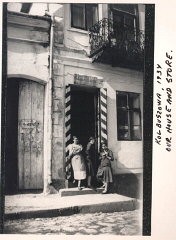
In this 1934 portrait of Norman Salsitz's family, Norman is seated in the front row (at left). In the top row, center, an image of one of Norman's brothers has been pasted into the photograph. This is seen by comparing the size of the brother's face with the others pictured. Pasting in images of family members who could not be present during family portraits was common practice and in some cases the resulting composite images are the only remaining visual records of family groups.
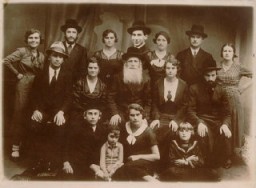
Four of Norman's sisters, the maid, and Norman's mother, Esther, do laundry in the yard of their home. Kolbuszowa, Poland, 1934.
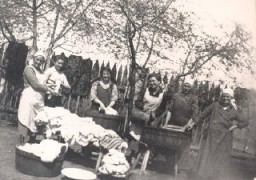
Survivors of the Wöbbelin camp wait for evacuation to an American field hospital where they will receive medical attention. Germany, May 4-6, 1945.
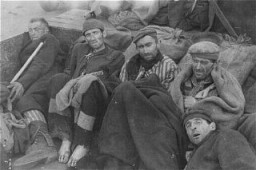
Survivors in a barracks at the Wöbbelin concentration camp. Germany, May 4–5, 1945.
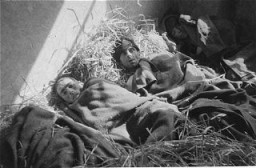
After the liberation of the camp, the US Army ordered the local townspeople to bury the corpses of prisoners killed in the camp. This photograph shows troops observing a moment of silence at a mass funeral for victims of the Wöbbelin camp. Germany, May 7, 1945.
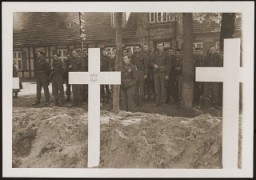
German civilians from Ludwigslust file past the corpses and graves of 200 prisoners from the nearby concentration camp of Wöbbelin. The US Army ordered the townspeople to bury the corpses on the palace grounds of the Archduke of Mecklenburg. Germany, May 7, 1945. Outraged by what they found upon entering the camp, the ranking Allied commanders in the area forced civilians from the nearby towns of Schwerin, Hagenow, and Ludwigslust to view the concentration camp and then bury the bodies of prisoners…
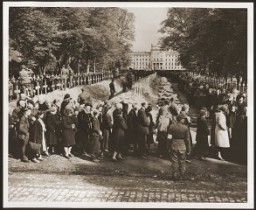
After the liberation of the Wöbbelin camp, US troops forced the townspeople of Ludwigslust to bury the bodies of prisoners killed in the camp. This photo shows US troops assembled at the mass funeral in Ludwigslust. Germany, May 7, 1945.

Under orders from officers of the US 8th Infantry Division, German civilians from Schwerin attend funeral services for 80 prisoners killed at the Wöbbelin concentration camp. The townspeople were ordered to bury the prisoners' corpses in the town square. Germany, May 8, 1945.
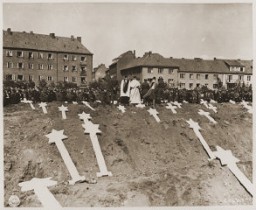
Flags of US Army liberating divisions on display at the United States Holocaust Memorial Museum in Washington D.C.
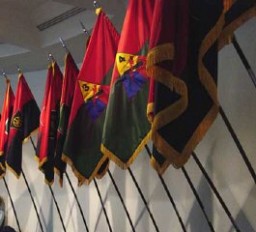
Flags of liberating divisions are presented during a ceremony at the Museum's Tribute to Holocaust Survivors: Reunion of a Special Family. This tribute was one of the United States Holocaust Memorial Museum's tenth anniversary events. Washington, DC, November 2003.
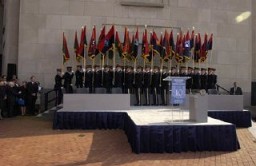
Ben Meed, President, American Gathering of Jewish Holocaust Survivors, standing in front of flags of the liberating divisions. This photograph was taken as he spoke at a ceremony held during the United States Holocaust Memorial Museum's Tribute to Holocaust Survivors: Reunion of a Special Family. This was one of the Museum's tenth anniversary events. Washington, DC, November 2003.
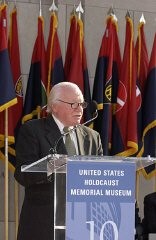
Elie Wiesel became Founding Chairman of the United States Holocaust Memorial Council in 1980. Here, he speaks at a ceremony held during the Tribute to Holocaust Survivors, one of the Museum's tenth anniversary events. Flags of US Army liberating divisions form the backdrop to the ceremony. Washington, DC, November 2003.
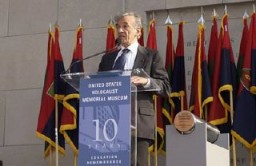
View of a ceremony held during the Museum's Tribute to Holocaust Survivors: Reunion of a Special Family, one of the United States Holocaust Museum's tenth anniversary events. Flags of the liberating divisions form the backdrop to the ceremony. Washington, DC, November 2003.

Scene during the 2001 Days of Remembrance ceremony, in the Rotunda of the US Capitol. Flags of the liberating divisions feature prominently in the Museum's Days of Remembrance ceremonies. Washington, DC, 2001.
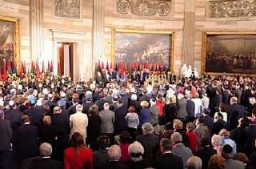
Insignia of the 65th Infantry Division. The 65th Infantry Division was nicknamed the "Battle Axe" after the divisional insignia, a halbert (an axe on a pole), used to cut through the enemy during medieval times.

Insignia of the 45th Infantry Division. The 45th Infantry Division gained its nickname, "Thunderbird" division, from the gold thunderbird. This Native American symbol became the division's insignia in 1939. It replaced another previously used Native American symbol, a swastika, that was withdrawn when it became closely associated with the Nazi Party.
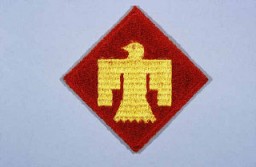
Insignia of the 42nd Infantry Division. The nickname of the 42nd Infantry Division, the "Rainbow" division, reflects the composition of the division during World War I. The division was drawn from the National Guards of 26 states and the District of Columbia. It represented a cross section of the American people, as the rainbow represents a cross section of colors.
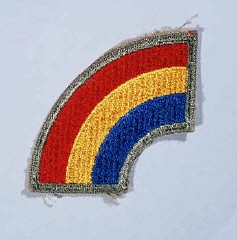
Insignia of the 36th Infantry Division. The 36th Infantry Division, the "Texas" division, was raised from National Guard units from Texas and Oklahoma during World War I. The "T" in the division's insignia represents Texas, the arrowhead Oklahoma. The division was also sometimes called the "Lone Star" division, again symbolizing its Texas roots.
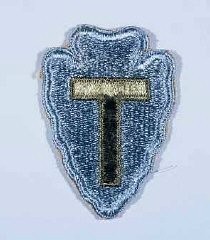
Insignia of the 29th Infantry Division. "Blue and Gray" was coined as the nickname of the 29th Infantry Division by the division's commander during World War I. The name commemorates the lineage of the mid-Atlantic states' National Guard units that formed the division, many with service on both sides during the Civil War.
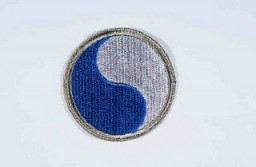
Insignia of the 69th Infantry Division. The 69th Infantry Division gained the nickname the "Fighting 69th" during World War II. The name has no heraldic significance, but simply conveys the esprit de corps of the division.
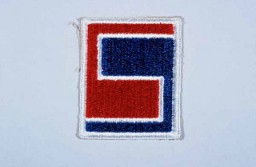
Insignia of the 71st Infantry Division. The nickname of the 71st Infantry Division, the "Red Circle" division, is based upon the divisional insignia (which includes a red circle).
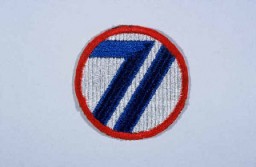
Medical corpsmen of the US 71st Infantry Division, 3rd US Army look on as captured German soldiers remove bodies from inside a barracks in Gunskirchen. In the foreground, a Jewish girl lies huddled in the straw on the floor of the barracks. Gunskirchen, Austria, May 7, 1945.
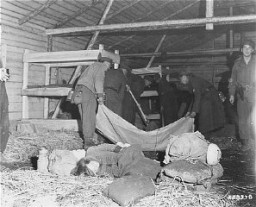
Corpses of prisoners killed in the Gunskirchen camp. Gunskirchen was one of the many subcamps of the Mauthausen camp. It was liberated by US forces in early May 1945. Gunskirchen, Austria, photo taken between May 6 and May 15, 1945.
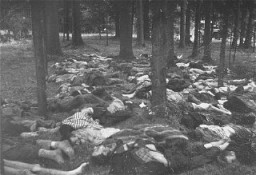
Corpses of victims of the Gunskirchen subcamp of the Mauthausen concentration camp. Austria, after May 5, 1945.
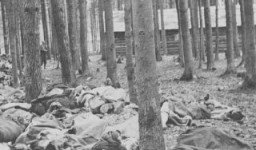
We would like to thank Crown Family Philanthropies, Abe and Ida Cooper Foundation, the Claims Conference, EVZ, and BMF for supporting the ongoing work to create content and resources for the Holocaust Encyclopedia. View the list of donor acknowledgement.